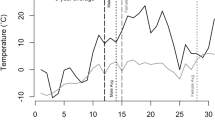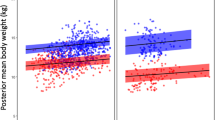Abstract
Researchers use the 13-lined ground squirrel for studies of hibernation biochemistry and physiology, as well as for modeling a variety of potential biomedical applications of hibernation physiology. It is currently necessary to capture research specimens from the wild; this presents a host of unknown variables, not least of which is the stress of captivity. Moreover, many investigators are unfamiliar with the husbandry of this species. The authors describe practical methods for their capture, year-round care (including hibernation), captive mating, and rearing of the young. These practices will allow the researcher to better standardize his or her population of research animals, optimizing the use of this interesting model organism.
This is a preview of subscription content, access via your institution
Access options
Subscribe to this journal
We are sorry, but there is no personal subscription option available for your country.
Buy this article
- Purchase on Springer Link
- Instant access to full article PDF
Prices may be subject to local taxes which are calculated during checkout





Similar content being viewed by others
References
Carey, H.V. & Martin, S.L. Preservation of intestinal gene expression during hibernation. Am. J. Physiol. 271 (5 Pt1), G804–G813 (1996).
Hittel, D.S. & Storey, K.B. Differential expression of mitochondria-encoded genes in a hibernating mammal. J. Exp. Biol. 205 (Pt 11), 1625–1631 (2002).
Epperson, L.E. & Martin, S.L. Quantitative assessment of ground squirrel mRNA levels in multiple stages of hibernation. Physiol. Genomics 10 (2), 93–102 (2002).
Andrews, M.T. Genes controlling the metabolic switch in hibernating mammals. Biochem. Soc. Trans. 32 (Pt 5), 1021–1024 (2004).
Carey, H.V., Andrews, M.T. & Martin, S.L. Mammalian hibernation: cellular and molecular responses to depressed metabolism and low temperature. Physiol. Rev. 83 (4), 1153–1181 (2003).
Arendt, T. et al. Reversible paired helical filament-like phosphorylation of tau is an adaptive process associated with neuron al plasticity in hibernating animals. J. Neurosci. 23 (18), 6972–6981 (2003).
Cai, D., McCarron, R.M. & Hallenbeck, J. Cloning and characterization of a forkhead transcription factor gene, FoxO1a, from thirteen-lined ground squirrel. Gene 343 (1), 203–209 (2004).
Lindell, S.L. et al. Natural resistance to liver cold ischemia-reperfusion injury associated with the hibernation phenotype. Am. J. Physiol. Gastrointest. Liver Physiol. 288 (3), G473–G480 (2005).
Wade, O. The behavior of certain spermophiles with special reference to aestivation and hibernation. J. Mamm. 11 (2), 160–188 (1930).
McCarley, H. Annual cycle, population dynamics and adaptive behavior of Citellus tridecemlineatus. J. Mamm. 47 (2), 294–316 (1966).
Rongstad, O.J. A life history study of thirteen-lined ground squirrels in southern Wisconsin. J. Mamm. 46 (1), 76–87 (1965).
Craven, S.R. Ground squirrels: their ecology and control. University of Wisconsin Cooperative Extension publication G3238. http://cecommerce.uwex.edu/pdfs/G3238.pdf.
Joy, J.E. & Mrosovsky, N. Synchronization of circannual cycles: a cold spring delays the cycles of thirteen-lined ground squirrels. J. Comp. Physiol. [A] 15 (1), 125–134 (1985).
Dripps, D. Studies on the ovary of the spermophile (Spermophilus citellus tridecemlineatus) with special reference to the corpus luteum. Amer. J. Anat. 25, 117–184 (1919).
Landau, I.T. & Holmes, W.G. Mating of captive thirteen-lined ground squirrels and the annual timing of estrus. Horm. Behav. 22 (4), 474–487 (1988).
Anderson, T. & Ribic, C. Predator activity and grassland bird nesting success in an agricultural landscape in southern Wisconsin. USGS Wisconsin Cooperative Wildlife Research Unit, University of Wisconsin Madison. http://dnr.wi.gov/org/land/er/cwcp/ribic-2004fieldreport-predators_091504.pdf.
Desha, P.G. Observations of the burrow utilization of the thirteen-lined ground squirrel. Southw. Nat. 11 (3), 408–410 (1966).
Larkin, J.E. & Heller, H.C. Sleep after arousal from hibernation is not homeostatically regulated. Am. J. Physiol. 276 (2 Pt2), R522–R529 (1999).
Johnson, G.E. & Wade, N.J. Laboratory reproduction studies on the ground squirrel, Citellus tridecemlineatus pallidus, Allen. Biol. Bull. 61, 101–114 (1931).
Johnson, G.E., Foster, M.A. & Coco, R.M. The sexual cycle of the thirteen-lined ground squirrel in the laboratory. Trans. Kans. Acad. Sci. 36, 250–269 (1933).
Barr, R.E. & Musacchia, X.J. Breeding among captive Citellus tridecemlineatus. J. Mamm. 49 (2), 343–344 (1968).
Bridgwater, D.D. Laboratory breeding, early growth, development and behavior of Citellus tridecemlineatus (Rodentia). Southw. Nat. 11 (3), 325–337 (1966).
Zimmy, M.L. Thirteen-lined ground squirrels born in captivity. J. Mamm. 46, 521–522 (1965).
Vispo, C.R. & Bakken, G.S. The influence of thermal conditions on the surface activity of thirteen-lined ground squirrels. Ecology 74 (2), 377–389 (1993).
Arenz, C.L. & Leger, D.W. Antipredator vigilance of juvenile and adult thirteen-lined ground squirrels and the role of nutritional need. Anim. Behav. 59 (3), 535–541, 2000.
Patrick, M.J. & Wilson, W.D. Parasites of the Abert's squirrel (Sciurus aberti) and red squirrel (Tamiasciurus hudsonicus) of New Mexico. J. Parasitol. 81 (2), 321–324 (1995).
Jahn, T.L., Bovee, E.C. & Jahn, F.F. How to Know the Protozoa 2nd Edn. (Wm. C. Brown Company Publishers, Dubuque, IA, 1979).
Rayor, L.S. & Armitage, K.B. Social behavior and space-use of young of ground-dwelling squirrel species with different levels of sociality. Ethol. Ecol. Evol. 3 (3), 185–206 (1991).
Luna, L.D. & Baird, T.A. Influence of density on the spatial behavior of female thirteen-lined ground squirrels, Spermophilus tridecemlineatus. Southw. Nat. 49 (3), 350–358 (2004).
McLean, I.G. in The Biology of Ground-Dwelling Squirrels: Annual Cycles, Behavioral Ecology, and Sociality (eds. Murie, J.O. & Michener, G.R.) 321–335 (University of Nebraska Press, Lincoln, NE, 1984).
Wistand, H. Individual, social, and seasonal behavior of the thirteen-lined ground squirrel, Spermophilus tridecemlineatus. J. Mamm. 55 (2), 329–347 (1974).
With, K.A. The hazards of nesting near shrubs for a grassland bird, the McCown's Longspur. Condor 96 (4), 1009–1019 (1994).
Livoreil, B. & Baudoin, C. Differences in food hoarding behavior in two species of ground squirrels Spermophilus tridecemlineatus and S. spilosoma. Ethol. Ecol. Evol. 8 (2), 199–205 (1996).
Devenport, J.A., Luna, L.D. & Devenport, L.D. Placement, retrieval, and memory of caches by thirteen-lined ground squirrels. Ethology 106 (2), 171–183 (2000).
Joy, J.E. in The Biology of Ground-dwelling Squirrels: Annual Cycles, Behavioral Ecology, and Sociality (eds. Murie, J.O. & Michener, G.R.) 125–141 (University of Nebraska Press, Lincoln, NE, 1984).
Schwagmeyer, P.L. & Wootner S.J. Scramble competition polygyny in thirteen-lined ground squirrels: the relative contributions of overt conflict and competitive mate searching. Behav. Ecol. Sociobiol. 19 (5), 359–364 (1986).
Schwagmeyer, P.L. in The Biology of Ground-dwelling Squirrels: Annual Cycles, Behavioral Ecology, and Sociality (eds. Murie, J.O. & Michener, G.R.) 275–294 (University of Nebraska Press, Lincoln, NE, 1984).
Schwagmeyer, P.L. & Foltz, D.W. Factors affecting the outcome of sperm competition in thirteen-lined ground squirrels. Anim. Behav. 39 (1), 156–162 (1990).
Yahyaoui, I.E., Gouat, P. & Livoreil, B. Male-male encounters in Spermophilus tridecemlineatus: comparison with other Spermophilus ictidomys species. C.R. Acad. Sci. Paris. 318, 229–235 (1995).
Schwagmeyer, P.L. & Parker, G.A. Mate-quitting rules for male thirteen-lined ground squirrels. Behav. Ecol. 5 (2), 142–150 (1994).
Acknowledgements
The authors thank Hannah V. Carey for assistance setting up our colony the first year and for subsequent encouragement and advice. They also thank Erin Jenewein, Julie Mullen, and Eric Zuniga for assistance with data collection and animal care; and John Oaks for advice on tapeworm identification. This work was supported by the University of Wisconsin Oshkosh Faculty Development and Undergraduate Student Collaborative Grant Programs.
Author information
Authors and Affiliations
Corresponding author
Ethics declarations
Competing interests
The authors declare no competing financial interests.
Rights and permissions
About this article
Cite this article
Vaughan, D., Gruber, A., Michalski, M. et al. Capture, care, and captive breeding of 13-lined ground squirrels, Spermophilus tridecemlineatus. Lab Anim 35, 33–40 (2006). https://doi.org/10.1038/laban0406-33
Received:
Accepted:
Issue Date:
DOI: https://doi.org/10.1038/laban0406-33
This article is cited by
-
Electron transport system supercomplexes affect reactive-oxygen species production and respiration in both a hibernator (Ictidomys tridecemlineatus) and a nonhibernator (Rattus norvegicus)
Journal of Comparative Physiology B (2023)
-
Torpid 13-lined ground squirrel liver mitochondria resist anoxia-reoxygenation despite high levels of protein damage
Journal of Comparative Physiology B (2023)
-
The association between increasing levels of O-GlcNAc and galectins in the liver tissue of hibernating thirteen-lined ground squirrels (Ictidomys tridecemlineatus)
Cell and Tissue Research (2020)
-
Regulation of mitochondrial metabolism during hibernation by reversible suppression of electron transport system enzymes
Journal of Comparative Physiology B (2017)
-
Substrate-specific changes in mitochondrial respiration in skeletal and cardiac muscle of hibernating thirteen-lined ground squirrels
Journal of Comparative Physiology B (2014)



